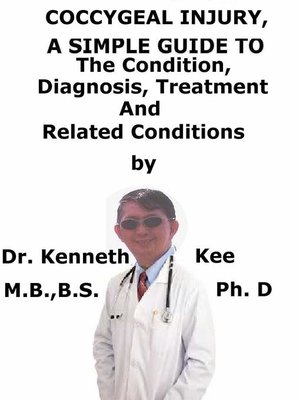Coccygeal Injury, a Simple Guide to the Condition, Diagnosis, Treatment and Related Conditions
ebook
By Kenneth Kee

Sign up to save your library
With an OverDrive account, you can save your favorite libraries for at-a-glance information about availability. Find out more about OverDrive accounts.
Find this title in Libby, the library reading app by OverDrive.



Search for a digital library with this title
Title found at these libraries:
| Library Name | Distance |
|---|---|
| Loading... |
This book describes Coccygeal Injury, Diagnosis and Treatment and Related Diseases
Coccygeal Injury is the injury (dislocation, fracture) of the coccyx bone bending forward after falls on the coccyx or repetitive injury to the coccyx.
The coccyx is at the bottom of the vertebral column.
The coccyx is the triangular bony structure sited at the end of the spine.
It comprises 3-5 segments which angulate forward to an inconsistent degree and are held in place by joints and ligaments.
The majority of coccyx injuries happen in women since the female pelvis is broader and the coccyx is more exposed.
Causes
Most coccyx injuries are caused by trauma to the coccyx area.
A fall onto the coccyx in the seated position, normally against a hard surface or on the stairs, is the most frequent cause of coccyx injuries.
A direct blow to the coccyx, such as those that happen during contact sports, can injure the coccyx.
The coccyx can be damaged or fractured during childbirth.
Repetitive straining or friction against the coccyx (as happens in bicycling or rowing) can damage the coccyx.
Occasionally, the cause of coccyx injuries is not known.
Less frequent causes of coccyx injuries are:
1. Bone spurs,
2. Compression of nerve roots,
3. Injuries to other parts of the spine,
4. Local infections, and
5. Tumors.
Symptoms:
The start is normally gradual unless due to acute trauma.
A coccyx injury causes pain and discomfort in the tailbone area (the disorder is called coccydynia).
These injuries may produce a bruise, dislocation, or fracture (break) of the coccyx and cause:
1. Pain when sitting on the coccyx
2. Pain is exacerbated by slumping or sitting on a hard seat
3. Pain is also exacerbated by constipation
4. The symptoms are more frequent in women.
Serious localized pain and tenderness may be felt in the coccyx area.
If the injury is traumatic, a bruise may be seen in this region.
The pain is normally worse when sitting for prolonged periods of time, or with direct pressure to the coccyx area.
Bowel movements and straining are often hurting.
Some women may feel pain during sexual intercourse.
It may be essential for the doctor to decide if the injury is traumatic or if the pain is produced by other, more severe, disorders.
Injuries to the region of the coccyx seldom necessitate a visit to the emergency department.
Diagnosis:
The cause of a coccyx injury is largely decided based on a medical history and a physical exam.
1. Local tenderness on palpation of the coccyx bone and the side soft tissues
2. Deformity of the coccygeal bone
Occasionally, X-rays may be taken to find out whether there is a fracture or dislocation.
Osteoarthritis may be observed at the sacro-coccygeal joint.
The complete vertebral column (spine) should be examined.
A neurological examination may be done.
A rectal examination may also be done.
The doctor inserts a finger into the rectum to palpate the region of the coccyx and feel if there is a dislocation or a fracture that can be felt and if direct pressure against the coccyx produces the pain.
Treatment
Coccyx injuries are often excessively painful, so home remedies are directed to regulate pain and prevent further irritation to the region.
The patient should avoid sitting down for long periods of time.
When seated, the patient should avoid sitting on hard surfaces and alternate sitting on each side of the buttocks.
Also, the patient should lean forward and direct the weight away from the coccyx.
For traumatic injuries, the patient...







